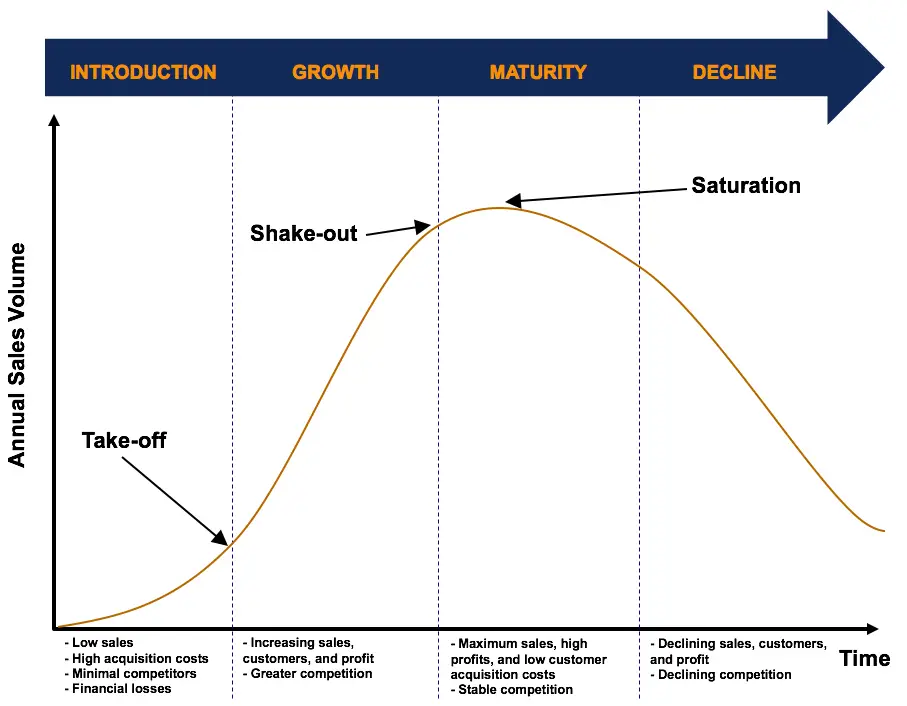
Stages of product life cycle
life cycle of a service
This affects the products offered by companies; sales vary, so it is necessary to adapt the marketing mix variables at each stage of the product’s life cycle, from its launch to its withdrawal.
Each stage refers to how the product is positioned in the market, which makes it possible to apply adapted marketing strategies (price, distribution and advertising). Adapting strategies for each stage enables companies to respond to consumer needs and to anticipate sales trends.
This concept is closely linked to the growth-share matrix or BCG matrix. In the BCG matrix there are 4 types of products and each of them can be related to a stage. The introduction phase can be related to the questioning product, the growth phase to the star product, the cow product to the maturity stage and the decline phase is equated with the dog product.
As mentioned above, the life cycle of a product consists of 4 phases: introduction/launch, growth, maturity and decline. The product life cycle has often been compared to the life cycle of a human being.
stages in the life cycle of a product examples
The product life cycle is the name given to the various stages that an item goes through from its launch on the market to its withdrawal. With this analysis model, it is possible to predict the trend in the evolution of sales of a given product, but some specific factors must be taken into account, because not all items are the same. In addition, the characteristics of the market in which it is marketed and of the company that produces it must be taken into account.
For marketing professionals, it is important to know the life cycle of products in order to implement the most appropriate commercial strategies in each phase. Therefore, the first step is to know what these four stages are.
Although these four stages occur in all products, it is important to remember that each product has a different life cycle. In some cases the life is very short, as is the case with some technological items; in others, such as food and beverages, they can stay alive for decades or even reappear after an absence.
product life cycle pdf
This affects the products offered by companies, sales vary, so it is necessary to adapt the marketing mix variables at each stage of the product’s life cycle from its launch to its withdrawal.
Each stage refers to how the product is found in the market, which allows to apply adapted marketing strategies (price, distribution and advertising). Adapting strategies for each stage enables companies to respond to consumer needs and to anticipate sales trends.
This concept is closely linked to the growth-share matrix or BCG matrix. In the BCG matrix there are 4 types of products and each of them can be related to a stage. The introduction phase can be related to the questioning product, the growth phase to the star product, the cow product to the maturity stage and the decline phase is equated with the dog product.
As mentioned above, the life cycle of a product consists of 4 phases: introduction/launch, growth, maturity and decline. The product life cycle has often been compared to the life cycle of a human being.
product life cycle 5 stages
Typically, a product that follows a normal life cycle goes through four stages. Starting with introduction, followed by growth, then maturity and ending with product decline.
Obviously, each stage has different characteristics and at each stage the company must apply a different marketing mix strategy. The needs of each stage must be taken into account and the different situations must be considered.
However, it should be clarified that not all products follow a normal life cycle; we can mention, for example, early-death products, which only enter the market and decline; and other cases may arise.
To begin with, introduction occurs when the product is launched on the market. As the product is not known, it generates very few sales. But as the target market begins to learn about its advantages, sales begin to increase slightly.
As a result, at this stage the most important element of the marketing strategy will be communication, because if people do not learn about the product, it will go straight from introduction to decline.
